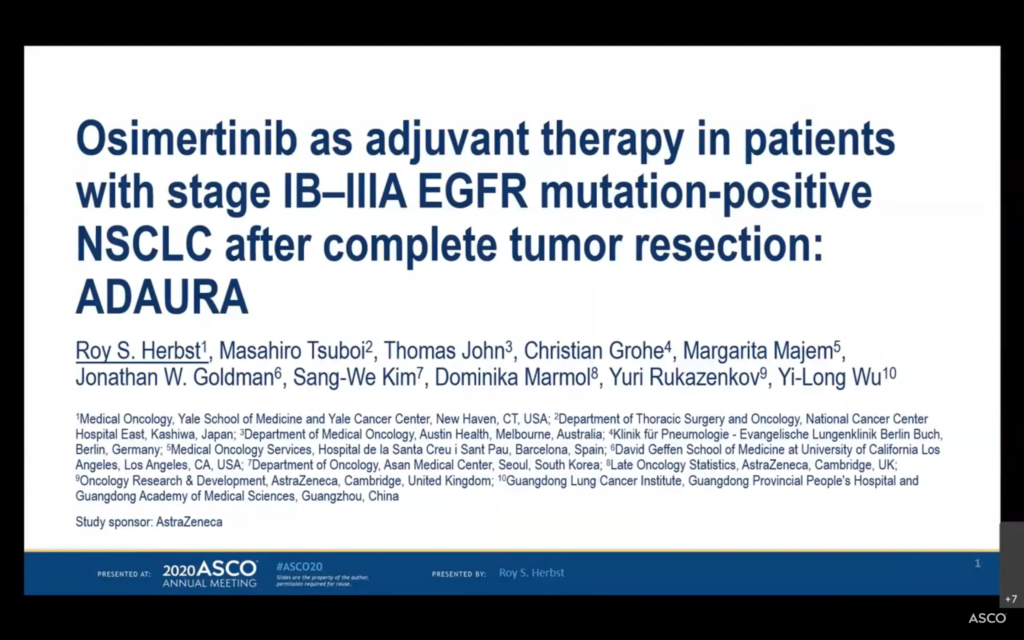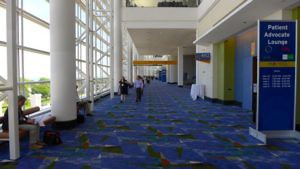Not in Chicago: A hallmark of the annual meeting of the American Society of Clinical Oncology (ASCO) is “practice changing” clinical trial data often featured in the plenary session.
This year one of the noteworthy phase 3 trials presented at the meeting (link to ASCO20 Abstract LBA5), was the AstraZeneca sponsored “ADAURA” trial for osimertinib as adjuvant therapy in patients with stage 1B-IIIA EGFR mutation-positive NSCLC after complete tumor resection.
We’ve been following the clinical development of osimertinib since the initial presentation of the phase 1 data in 2013 (link).

Source: ASCO20 Press Briefing by Dr Roy Herbst
At first glance it’s hard not to be wowed by the separation of the disease-free survival (DFS) curves in ADAURA, which show a benefit for patients who received the EGFR inhibitor osimertinib compared to those who received placebo. A 0.17 hazard ratio is certainly not something we see every day.
Indeed, if you were in the media and listened to Dr Herbst on the #ASCO20 press briefing last week – to use a “Britishism” – you would have thought this trial was “the best thing since sliced bread.” The data monitoring committee recommended unblinding the study early.

D Ross Camidge, MD PhD
Anyone leaving the story there and doing a superficial report about this data is, however, doing a disservice to their readers. The US academic lung cancer community are not all singing Handel’s Hallelujah chorus for the ADAURA trial and in this post, we take a critical look at why this might be the case.
For good measure, we interviewed a global thought leader who was prepared to offer some candid expert commentary.
Dr Ross Camidge is Professor of Medicine/Oncology and holds the Joyce Zeff Chair in Lung Cancer Research at the University of Colorado school of medicine. He kindly spoke to BSB and shared his perspective on adjuvant therapy in EGFR mutant lung cancer.
Dr Camidge characterized the disease-free survival in the ADAURA trial as a potential “false dawn” and told BSB:
“I do not believe the data should be practice changing or at least not yet. I think when you show there is an overall survival benefit then it will be practice changing…
So far there is no reason to suggest that disease free survival is going to translate into an overall survival advantage as it has not in any other comparable targeted therapy trial in EGFR mutant lung cancer. If this trial is the exception though, it will certainly not be of the same magnitude as the DFS benefit. However, the real unanswered questions are who needs this drug in this setting and if they need it, who can stop it safely and when.”
To learn more about the ADAURA trial presented at ASCO20 and read our latest expert interview, subscribers can log-in or you can click to gain access to BSB Premium Content.
This content is restricted to subscribers










 This weekend in the oncology conference calendar saw the ESMO Breast meeting take place.
This weekend in the oncology conference calendar saw the ESMO Breast meeting take place. Here we take an in-depth look at the emerging SERD landscape in ER+ metastatic breast cancer. There’s a lot going on the ER+HER2- niche these days after a bit of a lull once we saw the CDK4/6 inhibitors approved so it’s a good opportunity for some extended colour commentary on what could become a hot area in oncology over the next couple of years.
Here we take an in-depth look at the emerging SERD landscape in ER+ metastatic breast cancer. There’s a lot going on the ER+HER2- niche these days after a bit of a lull once we saw the CDK4/6 inhibitors approved so it’s a good opportunity for some extended colour commentary on what could become a hot area in oncology over the next couple of years. In this latest article, we highlight ten areas within the niche and include an array of companies, both big and small, across Pharma and Biotechs.
In this latest article, we highlight ten areas within the niche and include an array of companies, both big and small, across Pharma and Biotechs.